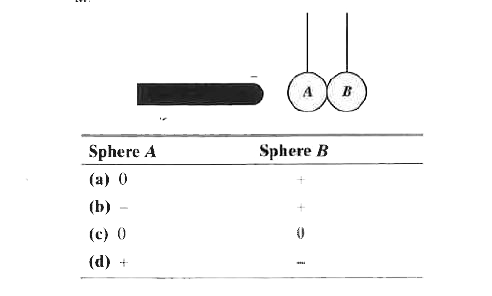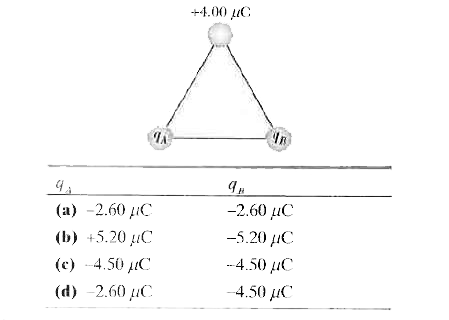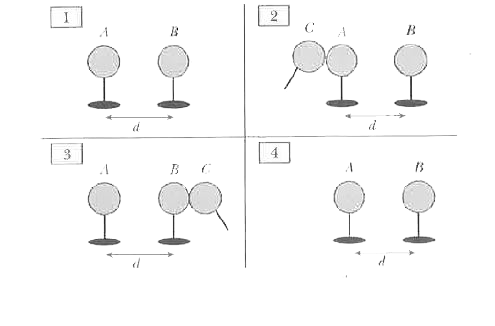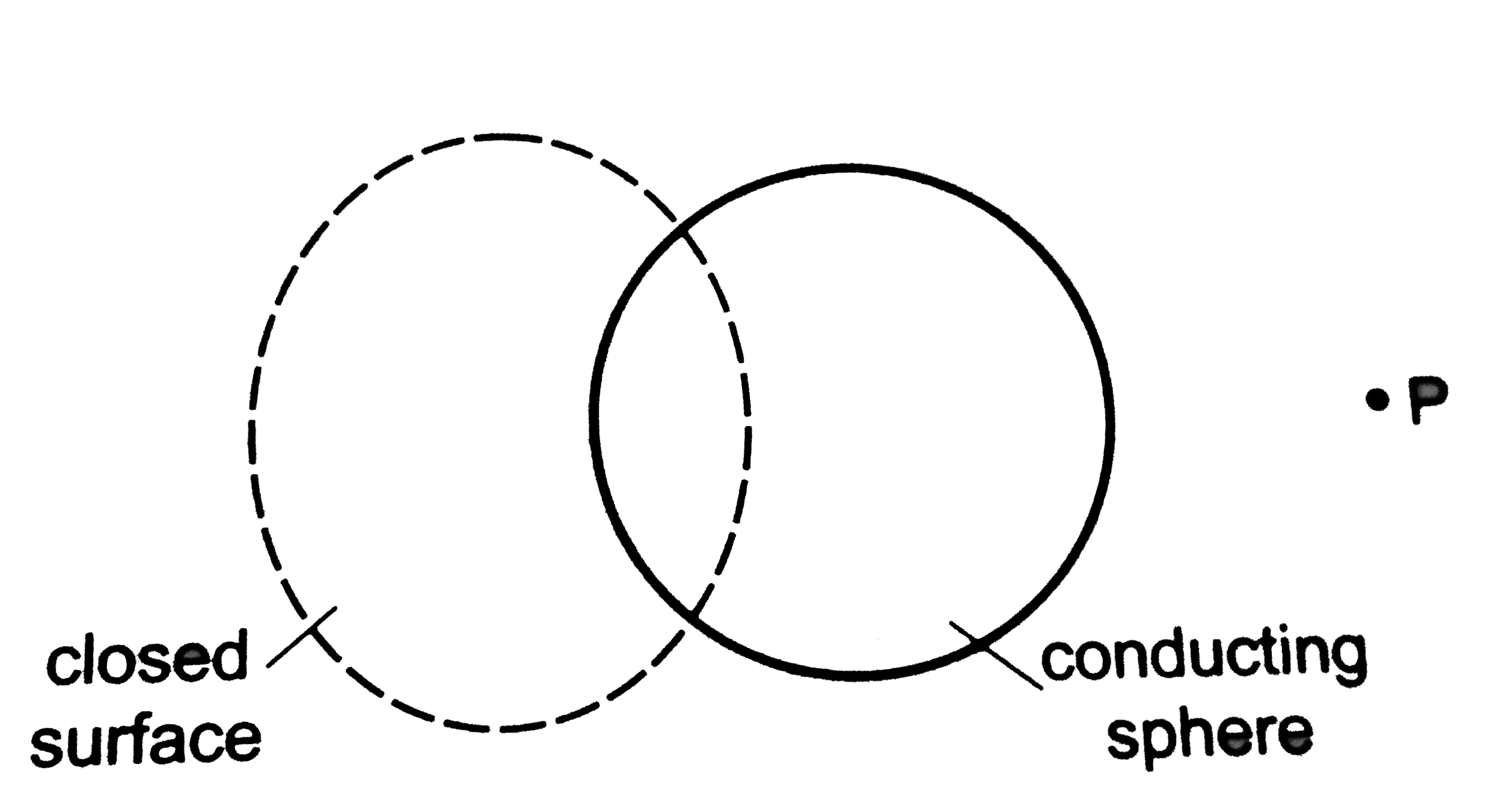Complete Solutions to Practice Questions (Single Correct Choice Type) of chapter ELECTRIC CHARGES AND FIELDS of Class 12 book with complete answers and questions
| Class 12 | PHYSICS |
| Chapter | ELECTRIC CHARGES AND FIELDS |
| RESNICK AND HALLIDAY | Practice Questions (Single Correct Choice Type) |
| Number Of Questions | 45 |
| Academic Year | 2023-24 |
Complete the following statement : When a glass rod is rubbed with silk cloth, the rod become positively charged as
View SolutionAn aluminium nail has an excess charge of `+3.2 muC`. How many electrons must be added to the nail to make it electrically neutral ?
View SolutionFour point charges, each of the same magnitude, with varying signs are arranged at the corners of square as shown in the figure below. Which of the arrows labelled A, B, C and D gives the correct direction of the net force that acts on the charge at the upper right corner ?

View SolutionFour point charges `q_(A) = 2 mu C , q_(B) = -5 mu C, q_(C) = 2 mu C and q_(D) = -5 mu C` are located at the corners of a square ABCD of side 10 cm. What is the force on a charge of `1 mu C` placed at the center of the square ?
View SolutionAssuming only electrostatic forces are present, electric field lines in the space surrounding a charge distribution show
View SolutionTwo uncharged conducting spheres, A and B, are suspended from insulating threads so that they touch each other as shown in the figure. While a negatively charged rod is held near, but not touching sphere A, someone moves ball B away from A. How will the spheres be charged, if at all ?

View SolutionA plate carries a charge of `-3.0 muC`, while a rod carries a charge of `+2.0 mu C`. How many electrons must be transferred from the plate to the rod, so that both objects have the same charge ?
View SolutionTwo point charges `q_(A) = 3 mu C` and `q_(B) = -3 muC` are located 20 cm apart in vaccum (a) what is the electric field at the mid point O of the line AB joining the two charges ? (b) If a negative test charge of magnitude `1.5xx10^(-9) C` is placed at the point, what is the force experienced by the test charge ?
View SolutionWhich one of the following statements is true concerning the strength of the electric field between two oppositely charged parallel plates ?
View SolutionTwo tiny conducting spheres are identical any carry charges of `-20.0 mu C` and `+50.0 muC`. They are separated by a distance of 2.50 cm. The spheres are brought into contact and then separated to a distance of 2.50 cm. Determine the magnitude of the force that each sphere now experiences, and state whether the force is attractive or repulsive.
View SolutionA `-4.0 mu C` charge is located 0.30 m to the left of a + `+ 6.0 mu C` charge. What is the magnitude and direction of the electrostatic force on the positive charge ?
View SolutionCorrect plot of `d tau//d theta.theta` vs `theta` in case of an electric dipole placed in any uniform electric field is
View SolutionConsider three identical metal spheres, A, B and C. Sphere A carries of `-2.0 mu C`, spheres B carries a charge of `-6.0 mu C`, and spheres C carries a charge of `+5.0 mu C`. Sphere A and B are touched together and then separated. Sphere B and C are then touched and separated. Does sphere C end up with an excess or a deficiency of electrons and how many electrons is it ?
View SolutionAn early model for an atom considered to have a positively charged point nucleus of charge Ze surrounded by a uniform density of negative charge up to a radius R. The atom as a whole is neutral. For this model, what is the electric field a distance r from the nucleus, where `r gt R` ?
View SolutionTwo identical charges `+Q` are kept fixed some distance apart.A small particles `P` with charge `q` is placed midway between them . If `P` is given a small displacement `Delta` ,it will undergo simple harmonic motion if
(i) `q` is positive and `Delta` is along the line joining the charges
(ii) `q` is positive and `Delta` is perpendicular to the line joining the charges
(iii) `q` is negative and `Delta` is perpendicular to the line joining the charges
(iv) `q` is positive and `Delta` is along the line joining the charges
View SolutionA charge Q exerts a 12 N force on another charge q. If the distance between the charges is doubled, what is the magnitude of the force exerted on Q by q?
View SolutionFour identical metallic objects carry the following charges : +1.6, +6.2, -4.8 and `-9.4 mu C`. The object are brought simultaneously into contact, so that each touches the others. Then they are separated, what is the final charge on each object ?
View SolutionThree charges are positioned as indicated in the following figure. What are the horizontal and vertical components of the net force exerted on the `+15 mu C` charge by the `+11 mu C` and `+13 mu C` charges ?

View SolutionAn electric dipole in a uniform electric field has potential energy U. The magnitude of the torque acting on the dipole due to the field is `tau`.
View SolutionAt which point (or points) in the given figure is the electric field zero N/C for the two point charges shown on the x axis ?

View SolutionA small object, which has a charge `q = 7.5 mu C` and mass `m = 9.0 xx 10^(-5) kg`, is placed in a constant electric field. Starting from rest, the object accelerates to a speed of `2.0 xx 10^(3)m//s` in a time of 0.96 s. Determine the magnitude of the electric field.
View SolutionIn the following figure, point A is a distance L away from a point charge Q. point B is a distance 4L away from Q. What is the ratio of the electric field at B to that at A, `E_(B)//E_(A)` ?

View SolutionFour point charges have equal magnitudes. Three are positive, and one is negative, as the drawing shows. They are fixed in place on the same straight line, and adjacent charges are equally separated by a distance d. Consider the net electrostatic force acting on each charge. Calculate the ratio of the largest to the smallest net force.

View SolutionWhat is the magnitude and direction of the electric force on a `-1.2 mu C` charge at a point where the electric field is 2500 N/C and is directed along the +y axis.
View SolutionThe membrane surrounding a living cell consists of an inner and an outer wall that are separated by a small space. Assume that the membrane acts like a parallel plate capacitor in which the effective charge density on the inner and outer walls has a magnitude of `7.1 xx 10^(-6) C//m^(2)`. What is the magnitude of the electric field within the cell membrane ?
View SolutionThe following figure shows the electric field lines in the vicinity of two charges. Which one of the following statements concerning this situation is true ?

View SolutionThere are four charges, each with a magnitude of `2.0 mu C`. Two are positive and two are negative. The charges are fixed to the corners of a 0.30 m square, one to a corner, in such a way that the net force on any charge is directed toward the center of the square. Find the magnitude of the net electrostatic force experienced by any charge.
View SolutionA rigid electric dipole is force to move in the electric field represented in the figure. Which one of the following phrases most accurately describes the initial motion of the dipole if it released from rest in the position shown ?

View SolutionThe following figure shows an equilateral triangle, each side of which has length of 2.00 cm. Point charges are fixed to each corner, as shown. The `4.0 mu C` charge experiences a net force due to the charges `q_(A)` and `q_(B)`. This net force points vertically downward and has a magnitude of 405 N. Determine the magnitudes and algebraic signs of the charges `q_(A)` and `q_(B)`.

View SolutionA conducting sphere carries a net charge of `-6 mu C`. The sphere is located at the center of a conducting spherical shell that carries a net charge of `+2 mu C` as shown in the figure. Determine the excess charge on the outer surface of the spherical shell.

View SolutionTwo identical conducting spheres carry charges of `+5.0 mu C` and `-10 mu C`, respectively. The centers of the spheres are initially separated by a distance L. The two spheres are brought together so that they are in contact. The spheres are then returned to their original separation L. What is the ratio of the magnitude of the electric force on either sphere after the spheres are touched to that before they were touched ?
View SolutionA charge +q is located at the origin, while an identical charge is located on the x axis at x = +0.50 m. A third charge of +2 q is located on the x axis at such a place that the net electrostatic force on the charge at the origin doubles, its direction remaining unchanged. Where should the third charge be located ?
View SolutionA charge of `-3.00 mu C` is fixed at the center of a compass. Two additional charges are fixed on the circle of the compass (radius 0.100 m). The charges on the circle are `-4.00 mu C` at the position due north and `+5.00 mu C` at the position due east. what is the magnitude and direction of the net electrostatic force acting on the charge at the center ? Specify the direction relative to due east.
View SolutionFour point charges have the same magnitude of `2.4 xx 10^(-12) C` and are fixed to the corners of a square that is 4.0 cm on a side. Three of the charges are positive and one is negative. Determine the magnitude of the net electric field that exists at the center of the square.
View SolutionAt a distance `r_(1)` from a point charge, the magnitude of the electric field created by the charge is 248 N/C. At a distance `r_(2)` from the charge, the field has a magnitude of 132 N/C. Find the ratio `r_(2)//r_(1)` ?
View SolutionThree identical point charges, q, are placed at the vertices of an equilateral triangle as shown in the figure. The length of each side of the triangle is d. Determine the magnitude and direction of the total electrostatic force on the charge at the top of the triangle.

View SolutionOne mole of a substance contains `6.02 xx 10^(23)` protons and an equal number of electrons. If the protons could somehow be separated from the electrons and placed in very small, individual containers separated by `1.00 xx 10^(3)m`, what would be the magnitude of the electrostatic force exerted by one box on the other ?
View SolutionTwo identical charged spheres suspended from a common point by two mass-less strings of length `l` are initially at a distance d ( `d ltlt l`) apart because of their mutual repulsion . The charge begins to leak from both the spheres at a constant rate. As a result the charge approach each other with a velocity `v`. Then as a function of distance `x` between them .
View SolutionA thin semi-circular ring of radius r has a positive charge q distributed uniformly over it as shown in the figure. The net field `vec(E)` at the center O is

View SolutionIn Frame 1, two identical conducting spheres, A and B, carry equal amounts of excess charge that have the same sign. The spheres are separated by a distance d, and sphere A exerts an electrostatic force on sphere B that has a magnitude F. A third sphere, C, Which is handled only by an insulating rod, is introduced in Frame 2. Sphere C is identical to A and B except that it initially uncharged. Sphere C is touched first to sphere A, in Frame 2, and then to sphere B, in Frame 3, and is finally removed in Frame 4.

Determine the magnitude of the electrostatic force that sphere A exerts on sphere B in Frame 4.
View SolutionA large negatively charged object was placed on an insulated table. A neutral metallic ball rolled straight toward the object but stopped before touching it. A second neutral metallic ball rolled along the same path as the first ball. Struck the first ball driving it a bit closer to the negatively charged object and stopped. After all stopped rolling, the first ball was closer to the negatively charged object than the second ball. At no time did either ball touch the charged object. which statement is correct concerning the final charge on each ball ?
View SolutionFigure shown a closed surface which intersects a conducting sphere. If a positive charge is placed at the point P, the flux of the electric field through the closed surface

View SolutionIf we seal a pipe with two metal end caps around a point charge Q, the electric field outside the pipe will be
View SolutionA charge `Q_(0)` is placed at the center of spherical cavity of a conductor and another charge Q is placed outside the conductor as shown in the figure. The correct statement is :

View SolutionA positive point charge Q is kept (as shown in the figure) inside a neutral conducting shell whose centre is at C. An external uniform electric field E is applied. Then :

View Solution
Practice Questions (Single Correct Choice Type) questions and complete solutions for chapter ELECTRIC CHARGES AND FIELDS of RESNICK AND HALLIDAY PHYSICS (HINGLISH) of Class 12